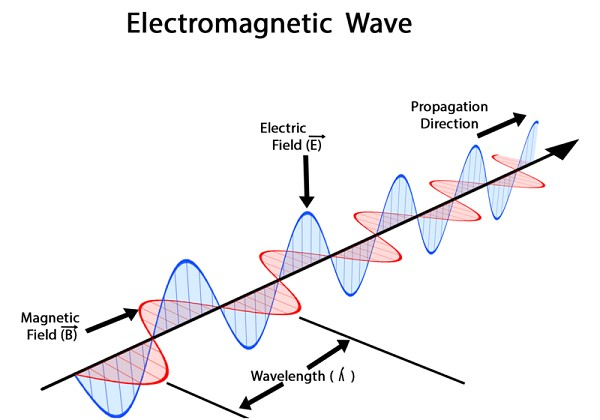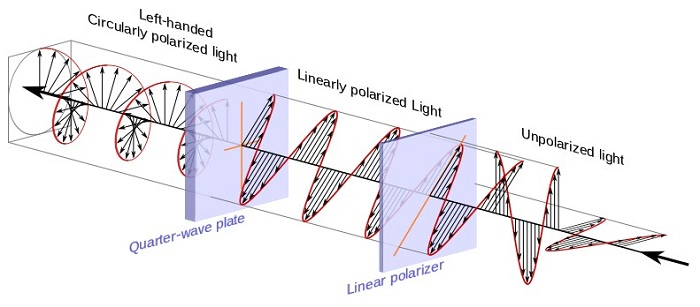Introduction
Light is represented by an Electromagnetic Wave (EMW), where it travels by oscillating electric and magnetic field intensities simultaneously. Here, the electric field will be perpendicular to the magnetic field and vice versa. Not only that, these two components together oscillate perpendicular to the direction of propagation of light waves.
Mainly, oscillations due to electric fields in a plane are considered for the light as electromagnetic waves when compared to magnetic fields. Hence, light electromagnetic waves are also called transverse waves. Since the atoms that produce EMW can vibrate or oscillate in all directions, it will be difficult to focus the light at a spot we need. For some applications the intensity of light should be reduced like in vehicles to prevent accidents, there shouldn’t be a back reflection of bright light.

DECHAMMAKL, Electromagnetic waves, CC BY-SA 4.0
To overcome this type of issue, the brightness of light wave intensities should be reduced by starting the atoms to oscillate in all directions and thus allowing light waves to propagate in one direction only. This process is called polarization and it is done by using polaroids.
What is Polarization?
We know the light is a transverse nature of electromagnetic waves where the electric field is considered and it travels perpendicular to the light propagation in a plane. The particles in the light oscillate in different directions, giving rise to the vibration of the electric field components in vibrating all the directions in a plane. So, in normal light, the vibration of the electric field will be in different directions leading to an unpolarised light. Suppose we constrained all the vibrations of the electric field in every direction except in one direction, it is said to be polarised light and this process of obtaining polarised light is termed polarization.

Dave3457, Circular.Polarization.Circularly.Polarized.Light Circular.Polarizer Creating.Left.Handed.Helix.View,
Explore our latest online courses and learn new skills at your own pace. Enroll and become a certified expert to boost your career.
Types of polarisation of light
- Linear polarization
- Circular polarization− Same amplitude with 90 degrees phase difference.
- Elliptical polarization− Different amplitudes with 90 degrees phase difference.
What are Polaroids?
Polarization of light can be obtained by passing unpolarized light through a thin sheet of crystal material. This thin crystal material is known as Polaroids or polarizers. The molecules in the polaroids are positioned in a particular direction, which is said to be the axis of the polaroids, which helps in allowing only those oscillated electric fields which are in line with this axis. Hence, producing a polarized light.
What are Polaroid Films?
Polaroid films are made up of organic materials having long chains of molecules or atoms that are aligned in a particular direction. In Polaroid films, the crystal material molecules are placed between two glass-like sheet substances. In making polaroid films, the crystal material we consider is quinine sulfate or herapathite which are placed between two transparent nitrocellulose polymer films. These crystals are then aligned by applying electric or magnetic fields in a particular direction giving the axis of the polaroids.
How light is polarized using polaroid film?
When an unpolarized light having a transverse electric field oscillating in all directions passes through the polaroid film, a polarized light wave oscillating in one direction will get transmitted out of the polaroid. The direction of transmitted polarised light depends on the direction of alignment of the crystal of atoms or molecules inside the polaroid film. This helps in reducing the intensity or brightness of the light which is used for many light applications. If I0I0 is the full intensity of an unpolarized light passing through the polaroid films, then the transmitted light intensity from the polaroid will be I. Suppose the angle between the direction of polarized light to the axis of the polaroid is θθ, then the amplitude of transmitted wave will be EcosθEcosθ. Here E is the amplitude of the electric field component. Then the relation between the intensity of unpolarized light to the intensity of transmitted polarized light is given according to Malu’s law as,
I=I0cos2θI=I0cos2θ
The direction of Polarization of Light
The direction of polarization of light is nothing but the direction of oscillation of the electric field after polarization. An unpolarized light where the electric field oscillates in all directions can be converted into polarized light, in which the electric field oscillates in one direction only. This process of allowing only one direction of EMW is achieved by using polaroids. Hence, polaroids can control the directions of light propagation. It means the direction of propagation of polarised light will be the direction of the polaroid axis on the film.
Leave a Reply